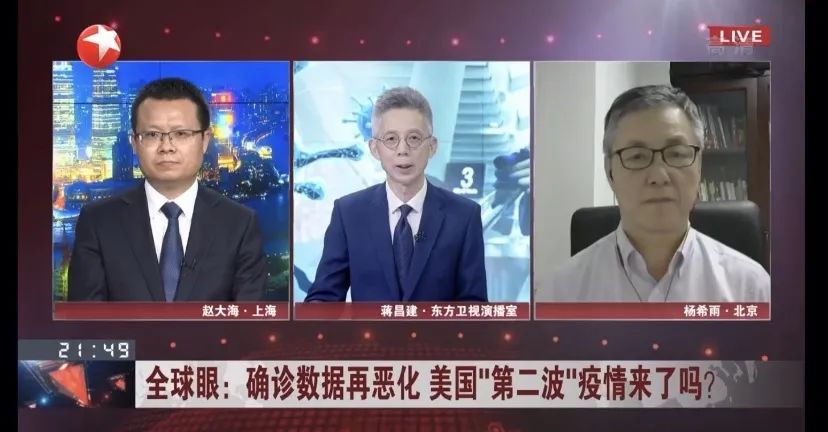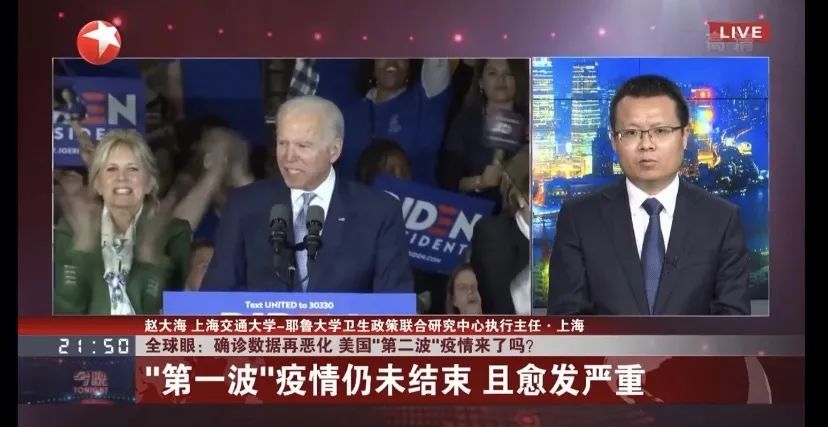上海交大赵大海关于新冠疫情第43次在电视台访谈评论:美国新冠疫情政治化阻碍了全球疫情抗击
上海交通大学国际与公共事务学院博士生导师、上海交通大学-耶鲁大学卫生政策联合研究中心执行主任赵大海,对于新冠肺炎疫情暴发与防控第17次做客上海电视台进行评论,也是第43次在央视、上视进行访谈评论。在2020年6月29日,赵大海做客东方卫视演播室的《今晚》节目,就美国新冠疫情最新进展进行了直播解读和评论。演播室同期连线嘉宾是中国国际问题研究院杨希雨研究员。现将赵大海的访谈内容摘录如下。
主持人:请教一个技术问题,由于全美确诊病例数在近段时间激增,有分析认为美国的第二波疫情已经到来,那么您的判断是怎样的,赵先生?
赵大海:我的观点是美国新冠肺炎疫情的第一波一直就没有结束,这也是我长期所坚持的观点。主要的依据是从4月1号开始,一直到今天为止,美国新冠肺炎每日的确诊病例数都在2万左右或者超过2万。从4月1号到现在,每天新增病例最少的一天也超过了一万七千人。因此,确实美国新冠肺炎疫情的第一波一直没有结束。只是最近一段时间由于美国经济的重启以及全美的反种族歧视大游行的原因导致美国疫情进一步严重。
主持人:那我们知道在周末的时候,彭斯在白宫做了一个简报的时候就这么说,他说病例的激增是因为检测能力加强的缘故,那么这番言论的立即遭到了驳斥。美国疾控中心前主任汤姆弗里登说,可以100%的说病例激增和检测无关,是病毒传播加强的,或者是加速的原因,到底是哪种原因呢?
赵大海:我的观点跟美国CDC的前任主任弗里登的观点是一致的,美国副总统彭斯所持的观点是毫无逻辑和没有根据的,为什么这么讲呢?我举一个数字,就比较容易能解释,美国新冠肺炎核酸检测的阳性率,在两周之前的是5%,现在这个数字是7%,也就是说美国全民的核酸检测阳性率最近在两周的时间之内是上升了,因此就完全有依据可以说彭斯的这个观点是站不住脚的。
主持人:请教一下赵教授,简单地回应一下,美国的这个防疫形势令人堪忧,如果按照现在的趋势发展下去的话,会对全球的防疫的态势造成什么样的影响呢?赵先生简短的给我们回应一下。
赵大海:美国的疫情现在依然没有放缓,或者说可控的这个趋势,对于全球的疫情抗击而言是非常不利的,因为美国是发达国家当中现在唯一一个疫情还没有被控制住的国家。除了美国之外,现在疫情最为严重的是南美以及印度,包括未来的非洲,因为非洲一些国家的统计数据现在还没有完全展示出来。因此全世界需要美国尽快完成疫情的抗击,然后各国共同携手来帮助南美、非洲等发展中国家来共同战胜疫情。
供稿者:国务学院
日期:2020年6月30日
Dahai Zhao' 43th comments on TV during the Pandemic: Politicization of COVID-19 in US has hindered the global containment of the epidemic
Dahai Zhao, a doctoral supervisor at School of International and Public Affairs of Shanghai Jiao Tong University and Executive Director of Shanghai Jiao Tong University-Yale University Joint Research Center for Health Policy, has been interviewed by ShanghaiTV for the 17th time (the 43th time by CGTN / ShanghaiTV) since the COVID-19 pandemic. On June 29, 2020, Zhao commented on the latest development of COVID-19 in US on “Tonight”.
Anchor: As the number of confirmed cases in the United States has surged in recent times, some people think that the second wave of outbreaks in the United States has arrived. What do you think?
Zhao: My point of view is that the first wave of COVID-19 epidemic in the United States has never ended. This is also my long-held view. The main basis is that from April 1 until today, the number of daily confirmed cases of new coronary pneumonia in the United States is about 20,000 or more than 20,000. From April 1 to now, the number of new cases per day is more than 17,000. Therefore, it is true that the first wave of COVID-19 epidemic in the United States has not ended. It is only recently that the US epidemic has been further severed due to the restart of the US economy and the nationwide anti-racial discrimination march.
Anchor: Pence said that the surge in cases was due to the increased detection capabilities, so the remarks were immediately refuted. Freeden, the former director of the US Centers for Disease Control and Prevention, said that 100% of the cases have nothing to do with the detection, the virus transmission is strengthened, or the reason is accelerated. Which one do you prefer regarding the talking?
Zhao: My views are consistent with the views of the former director of the US CDC, Frieden. The positive rate of nucleic acid test for COVID-19 in the United States was 5% two weeks ago, and now this figure is 7%, which means that the positive rate of nucleic acid test in the United States has recently risen within two weeks. Therefore, this view of Pence is untenable.
Anchor: This epidemic prevention situation in the United States is worrisome. If it develops according to the current trend, what impact will it have on the global epidemic prevention situation?
Zhao: The epidemic in the United States is still not slowing down, or this trend of controllability is very unfavorable for the global epidemic situation. Because the United States is the only country among developed countries that has not yet been controlled. Apart from the United States, South America and India are the most severely affected. And statistics of some African countries have not yet been fully displayed. Therefore, the world needs the United States to complete the fight against the epidemic as soon as possible, and then all countries will work together to help developing countries such as South America and Africa to jointly overcome the epidemic.
Contributor: SIPA, SJTU
Data: June 30

